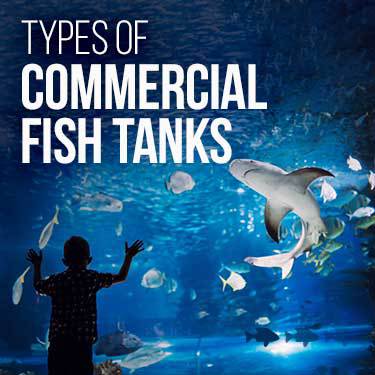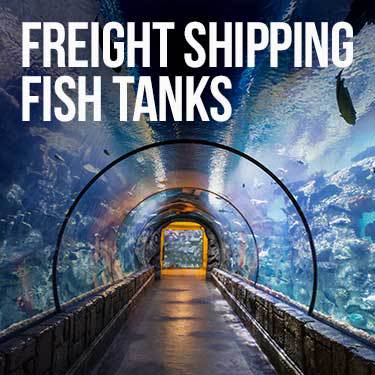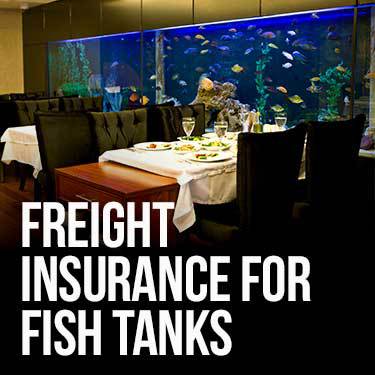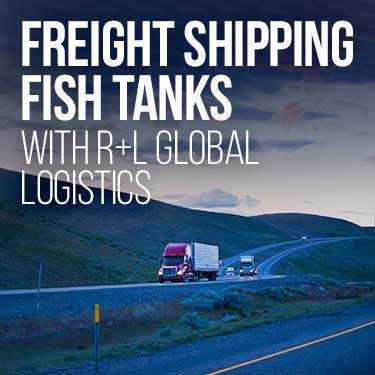Freight shipping fish tanks can be a Shamu-sized job, especially if you need commercial rather than residential tanks transported. And while fish tanks are built to withstand both water pressure and everyday life, the fact remains that much of the materials used to construct these objects are glass and sealants. So it’s absolutely necessary that the utmost care and preparation be taken.
In order to undertake freight shipping fish tanks, which is the act of sending the products from its manufacture point to the end customer, it’s imperative to find the right kind of truck based on the sizes of the tanks and also partner with a company that has a proven track record of being able to handle such an important job.

While a nice little fishbowl or a 10-gallon tank is where most people’s minds go when thinking about fish tanks, the purpose of this article is to think bigger. In some cases, much bigger. On the lowest end, the elaborate fish tanks in restaurants fall outside of the realm of those that would be considered residential.
But commercial fish tanks quickly scale upward from those used at fish farms or hatcheries to those used at zoos or aquariums. Even those used in bigger pet stores are different from the ones most readily available to regular homeowners.
Besides what they’ll be used for, commercial fish tanks might have drains, complex filtration systems or be built differently to accommodate easier viewing and immersion for customers or for those who have to work in or around the tanks.
Fish tanks aren’t always made of inches-thick glass depending on their use. As an example, at a fish farm, aquaculture tanks might be made out of plastic or fiberglass and more closely resemble giant outdoor pools rather than a more traditional rectangular, glass-dominant fish tank.
The one thing all commercial fish tanks share is they are not cheap. While they enjoy a wide range of prices, from thousands of dollars up to the $290 million it cost to build the Georgia Aquarium in Atlanta before it opened in 2005. That large sum was not devoted strictly to creating the tanks to house the different marine life, it surely made up a decent portion of the cost and doesn’t even factor in the hundreds of millions of dollars in expansions undertaken later.
If you think that expenditure is breathtaking, it was soon surpassed in 2014 by Chimelong Ocean Kingdom in China. That 353-acre aquarium had a price tag of $1 billion and has nearly 13 million gallons of water held by some of the largest fish tanks in the world.
Regardless of if you’re building a new aquarium or needing tanks for fish farms or another business, the main point is these are generally valuable, possibly fragile and most likely very important to what you’re trying to accomplish. So knowing exactly what you need and that it could cost big bucks is handy for planning.

Although the title of the section clearly states it is about freight shipping fish tanks, that’s because manufacturers often deem it necessary to ship both (sizable) residential and commercial variants via freight rather than by the United States Postal Service or other parcel services such as FedEx and UPS.
This is due to the very nature of the tanks: they can be very heavy, mostly glass constructions that cannot afford to be damaged in any way. Even the slightest crack or imperfection in the glass or seals can cause the components of the tank — and in turn, the tank itself — to be rendered useless or need costly repairs before they’re even set up.
For bigger tanks or pieces of tanks to be built later, the preferred method for moving them on and off the truck is by forklift or other machinery. That is because of the sheer weight of some of the tanks involved and their potential fragility leading them to be easily damaged by unsteady hands.
Depending on the size and shape of the fish tanks, a standard 18-wheeler can be used for transportation but some are too big for this type of truck and can necessitate a specialty flatbed — possibly oversized to hold a very large tank — in order to get it to where it needs to go.
Another aspect that will determine the exact kind of truck other than the overall size is whether the fish tanks are being shipped already assembled or in parts that will be assembled once at the selected location.
Going back to the size of the tanks, it will help determine if the tanks can be enclosed in any kind of protective shipping materials that can be reasonably used to try and shield the products from the bumps and shifts that come along with road transport.

There are many commodities where purchasing additional freight insurance, outside of the cargo liability included on a freight load, might not be worth the extra expenditure. Fish tanks, however, are one of the commodities where this should definitely be looked into.
Because fish tanks built for a commercial setting are generally very large, very fragile and likely very expensive, making sure you have the full value (or close to it) covered is more of a need than a want. Freight shippers will offer a fractional amount of carrier liability as part of their load quote. However, this type of coverage is very limited and responsible for damage that is proven to be the shipper’s fault. Furthermore, it’s extremely likely that only a small portion of any damages will be financially reimbursed.
Therefore, it is imperative that you seek to protect yourself and your products by investigating the purchase of supplementary freight insurance. For varying costs, you can get partial or even full monetary value coverage. Obviously, the more coverage you need, the more it will cost.
You can choose to obtain this additional insurance in one of two ways. You can ask the logistics company that is shipping your freight to procure it for you, which might mean that they are going to a third party themselves and buying it on your behalf. Or you can take the task into your own hands and shop around for the best rate among multiple third-party providers. This gives you slightly more control over what exactly is covered and the ability to gather a number of different rates. There is no best way to choose between the two. If you don’t want the responsibility or time commitment of searching, having the third-party logistics company do it for you will be the better way to go. But if you find that more control over the process is what you crave with such an important undertaking, then doing it yourself may very well be preferable.

Now that you consider yourself completely up to date on how to start freight shipping fish tanks, go the extra mile by acquiring an exceptional partner in R+L Global Logistics.
If a commodity is able to be freight shipped, we have experience with it. No matter the size of the tank or the level of care needed during transport, R+L Global Logistics can handle it for you with ease. Whether you require an 18-wheeler to haul your tanks or a specialty flatbed, we’ve got you covered.
Besides just experience and care given to your freight, there are some other concrete reasons that going with R+L Global Logistics is the right move. For instance, we also pride ourselves with accurate delivery time with our freight shipments and our 99.5 percent on-time delivery rate backs that up. We also have expedited shipping for your specific needs, should you require your fish tanks to reach their destination even faster.
Furthermore, R+L Global Logistics’ customer service team is an industry leader at making sure those who hire us to deliver their freight are well taken care of. Whether it’s a simple question about any aspect of the transportation process, or a concern regarding your specific shipment, we’ll quickly and professionally address those.
Also, if you’re wondering how you’re going to protect this awesome level of investment during a crucial part of its journey, it’s a smart move to consider purchasing additional freight insurance. This can enhance the amount of coverage for your fish tanks during transit and is something that R+L Global Logistics can help secure for you. Tell us the amount of insurance you need and we’ll make it happen.
So once freight shipping fish tanks are on your radar, give the best in the business at R+L Global Logistics a call to set up a time, place and date to transport your load. For a free quote today, call us at 866.353.7178.
R+L Global Logistics
315 NE 14th St., Ocala, FL 34470